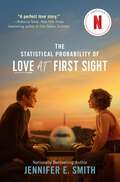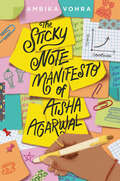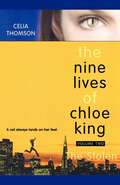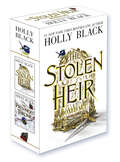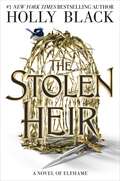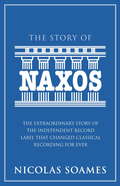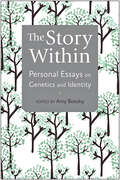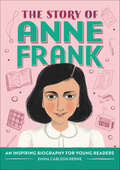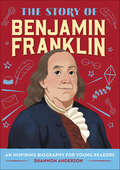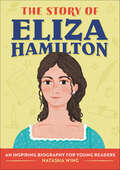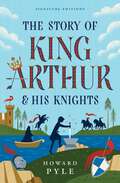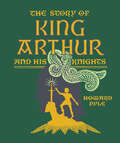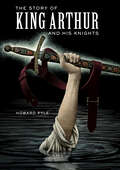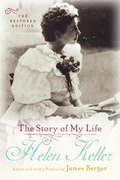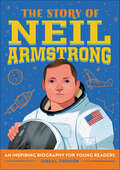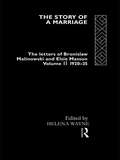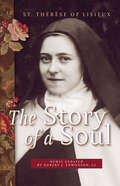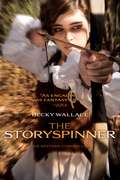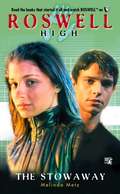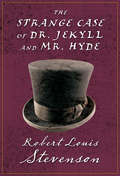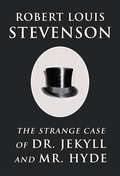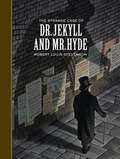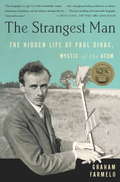- Table View
- List View
The Statistical Probability of Love at First Sight (Playaway Young Adult Ser.)
by Jennifer E. SmithNow a NETFLIX feature film starring Haley Lu Richardson! Timing is everything in this romantic novel about family connections, second chances, and first loves. Set over a twenty-four-hour-period, Hadley and Oliver find that true love can be found in unexpected places. Today should be one of the worst days of Hadley Sullivan's life. Having just missed her flight, she's stuck at the airport and late to her father's wedding, which is taking place in London and involves a soon-to-be stepmother Hadley's never even met. Then she happens upon the perfect boy in the airport's cramped waiting area. His name is Oliver, he's British, and he's sitting in her row.... A long night on the plane passes in the blink of an eye, and Hadley and Oliver lose track of each other in the airport chaos upon arrival. Can fate intervene to bring them together once more?
The Sticky Note Manifesto of Aisha Agarwal
by Ambika VohraIn this heartfelt and hilarious debut from Ambika Vohra—that's Netflix's Never Have I Ever meets Jenny Han—one girl tackles a question that changes the trajectory of her senior year: "How have you gotten out of your comfort zone?" That’s the Stanford admissions prompt that valedictorian shoo-in Aisha Agarwal can’t answer. Comfort zone? Her life’s been homework and junk food for as long as she can remember. Not exactly the thing college essays are written about. So, when her crush, Brian, asks her to winter formal, Aisha thinks her fate is changing . . . . . . until Brian stands her up.As if on cue, a banged-up Volkswagen arrives outside the dance; the driver—a guy her age—profusely apologizing for being late to pick her up. Does Aisha know him or what he's talking about? No. Does the Stanford essay convince her to take him up on the ride? Absolutely.To Aisha’s relief, seventeen-year-old Quentin Santos isn’t a kidnapper, but he is failing math. So, they strike a deal: If Aisha helps Quentin pass math, he’ll help push her out of her comfort zone, using a series of sticky note to-do’s—dares—that will not only give Aisha content for her essay but will turn her into the confident person she’s always wanted to be.From New Year’s Eve kisses to high school parties, Aisha’s sticky note manifesto is taking off. But when she falls for the wrong guy, hurts her best friend, and still can’t finish her essay, victory feels far from reach. Is winning worth it if you end up losing yourself in the process?
The Stolen (The Nine Lives of Chloe King #2)
by Celia ThomsonShe argues with her mother. She occasionally skips class. And she alternately crushes on two totally different boys.But Chloe King is by no means your typical teenager. The girl can scale buildings and see in the dark. Sometimes, at night, she even likes to leap from rooftop to rooftop. Yes, Chloe has the instincts and ability of a cat. And that makes her unique indeed.It also makes her a wanted woman.Because the Order of the Tenth Blade does not deal kindly with people like Chloe. It stalks them. Preys upon them. And wants many of them -- like Chloe, for instance -- dead.
The Stolen Heir Digital Omnibus
by Holly BlackAn Instant #1 New York Times Bestseller! An Instant #1 Indie Bestseller! Return to the opulent world of Elfhame, filled with intrigue, betrayal, and dangerous desires, with this first book of a captivating new duology from the #1 New York Times bestselling author Holly Black. A runaway queen. A reluctant prince. And a quest that may destroy them both. Eight years have passed since the Battle of the Serpent. But in the icy north, Lady Nore of the Court of Teeth has reclaimed the Ice Needle Citadel. There, she is using an ancient relic to create monsters of stick and snow who will do her bidding and exact her revenge. Suren, child queen of the Court of Teeth, and the one person with power over her mother, fled to the human world. There, she lives feral in the woods. Lonely, and still haunted by the merciless torments she endured in the Court of Teeth, she bides her time by releasing mortals from foolish bargains. She believes herself forgotten until the storm hag, Bogdana chases her through the night streets. Suren is saved by none other than Prince Oak, heir to Elfhame, to whom she was once promised in marriage and who she has resented for years. Now seventeen, Oak is charming, beautiful, and manipulative. He&’s on a mission that will lead him into the north, and he wants Suren&’s help. But if she agrees, it will mean guarding her heart against the boy she once knew and a prince she cannot trust, as well as confronting all the horrors she thought she left behind.
The Stolen Heir: A Novel of Elfhame (The Stolen Heir)
by Holly BlackAn Instant #1 New York Times Bestseller! An Instant #1 Indie Bestseller! Return to the opulent world of Elfhame, filled with intrigue, betrayal, and dangerous desires, with this first book of a captivating new duology from the #1 New York Times bestselling author Holly Black. A runaway queen. A reluctant prince. And a quest that may destroy them both. Eight years have passed since the Battle of the Serpent. But in the icy north, Lady Nore of the Court of Teeth has reclaimed the Ice Needle Citadel. There, she is using an ancient relic to create monsters of stick and snow who will do her bidding and exact her revenge. Suren, child queen of the Court of Teeth, and the one person with power over her mother, fled to the human world. There, she lives feral in the woods. Lonely, and still haunted by the merciless torments she endured in the Court of Teeth, she bides her time by releasing mortals from foolish bargains. She believes herself forgotten until the storm hag, Bogdana chases her through the night streets. Suren is saved by none other than Prince Oak, heir to Elfhame, to whom she was once promised in marriage and who she has resented for years. Now seventeen, Oak is charming, beautiful, and manipulative. He&’s on a mission that will lead him into the north, and he wants Suren&’s help. But if she agrees, it will mean guarding her heart against the boy she once knew and a prince she cannot trust, as well as confronting all the horrors she thought she left behind.
The Story Of Naxos: The Extraordinary Story of the Independent Record Label that Changed Classical Recording for Ever
by Nicolas SoamesIn 1987, a budget classical record label was started in Hong Kong by Klaus Heymann, a German businessman who loved classical music. Swiftly, it gained a world wide reputation for reliable new digital recordings of the classics at a remarkably low price. Despite opposition from the classical record establishment, it grew at a remarkable pace, and soon expanded into opera, early music, contemporary music and specialist repertoire so that it became appreciated by specialist collectors as well as the general music lover. It is now the leading provider of classical music and as an innovator in digital delivery. At the heart of Naxos is one man: Klaus Heymann. The combination of his broad knowledge of classical music and his acute business acumen has enabled him to build the most varied classical music label in the world, but also the most effective distribution network to ensure that his recordings are available everywhere. This fascinating story explains how it happened, how a one-time tennis coach in Frankfurt became a classical recording mogul in Hong Kong and how, at the age of 75, he still holds the reins as firmly as ever.
The Story Within: Personal Essays on Genetics and Identity
by Amy BoeskyA thought-provoking collection of personal essays explores complex issues surrounding genetic identity.The contributors to The Story Within share powerful experiences of living with genetic disorders. Their stories illustrate the complexities involved in making decisions about genetic diseases: whether to be tested, who to tell, whether to have children, and whether and how to treat children medically, if treatment is available. More broadly, they consider how genetic information shapes the ways we see ourselves, the world, and our actions within it. People affected by genetic disease respond to such choices in varied and personal ways. These writers reflect that breadth of response, yet they share the desire to challenge a restricted sense of what "health" is or whose life has value. They write hoping to expand conversations about genetics and identity—to deepen debate and generate questions. They or their families are affected by Huntington’s disease, Alzheimer’s disease, cancer, genetic deafness or blindness, schizophrenia, cystic fibrosis, Tay-Sachs, hypertrophic cardiomyopathy, fragile X, or Fanconi anemia. All of their stories remind us that genetic health is complicated, dynamic, and above all, deeply personal.ContributorsMisha Angrist, Amy Boesky, Kelly Cupo, Michael Downing, Clare Dunsford, Mara Faulkner, Christine Kehl O’Hagan, Charlie Pierce, Kate Preskenis, Emily Rapp, Jennifer Rosner, Joanna Rudnick, Anabel Stenzel (deceased), Isabel Stenzel Byrnes, Laurie Strongin, Patrick Tracey, Alice Wexler
The Story Within: Personal Essays on Genetics and Identity
by Amy Boesky“A compelling collection of essays that address the experiences of many who have genetically based illnesses.” —Library JournalThe contributors to The Story Within share powerful experiences of living with genetic disorders. Their stories illustrate the complexities involved in making decisions about genetic diseases: whether to be tested, who to tell, whether to have children, and whether and how to treat children medically, if treatment is available. More broadly, they consider how genetic information shapes the ways we see ourselves, the world, and our actions within it.People affected by genetic disease respond to such choices in varied ways. These writers reflect that breadth of response, yet they share the desire to challenge a restricted sense of what “health” is or whose life has value. They write hoping to expand conversations about genetics and identity—to deepen debate and generate questions. They or their families are affected by Huntington’s disease, Alzheimer’s disease, cancer, genetic deafness or blindness, schizophrenia, cystic fibrosis, Tay-Sachs, hypertrophic cardiomyopathy, fragile X, or Fanconi anemia. All of their stories remind us that genetic health is complicated, dynamic, and above all, deeply personal.Contributors include: Misha Angrist, Amy Boesky, Kelly Cupo, Michael Downing, Clare Dunsford, Mara Faulkner, Christine Kehl O’Hagan, Charlie Pierce, Kate Preskenis, Emily Rapp, Jennifer Rosner, Joanna Rudnick, Anabel Stenzel, Isabel Stenzel Byrnes, Laurie Strongin, Patrick Tracey, Alice Wexler
The Story of Anne Frank: An Inspiring Biography for Young Readers (The Story Of)
by Emma Carlson BerneDiscover the life of Anne Frank—a story about staying hopeful for kids ages 6 to 9 Anne Frank was a young Jewish girl who lived during World War II, when people like her were killed just for being Jewish. Anne and her family were forced to hide in a tiny, secret space to try and survive, and Anne began keeping a diary to practice her love of writing and pass the time.In her writing, she described what life was like as a Jewish person during the war. She also wrote about her hopes, dreams, and the future she wanted when she could live a normal life again. Even though she was scared, Anne believed in the goodness of people and never gave up hope that life would get better again.Independent reading—This Anne Frank biography is broken down into short chapters and simple language so kids 6 to 9 can read and learn on their own.Critical thinking—Kids will learn the Who, What, Where, When, Why, and How of Anne's life, find definitions of new words, discussion questions, and more.A lasting legacy—Find out how Anne Frank helped make the world a better place for future generations, including you.How will Anne's bravery and optimism inspire you?Discover activists, artists, and athletes, and more from all across history with the rest of The Story Of series, including famous figures like: Albert Einstein, Ruth Bader Ginsburg, Ruby Bridges, Amelia Earhart, and Frida Kahlo.
The Story of Benjamin Franklin: An Inspiring Biography for Young Readers (The Story of Biographies)
by Shannon AndersonDiscover the life of Benjamin Franklin—a story about curiosity, big ideas, and helping others for kids ages 6 to 9Benjamin Franklin was a brilliant inventor, scientist, writer, and founding father. Before his ideas made him a legend, Benjamin was a young boy who enjoyed learning, helping others, and problem-solving. He was always finding clever ways to make the world a better place, from inventing the lightning rod to helping write the U.S. Constitution.Explore how Benjamin Franklin went from being a thoughtful kid growing up in Boston to an American hero who created the country's first public library, post office, hospital, and fire station in this biography for kids.Independent reading—This Benjamin Franklin biography is broken down into short chapters and simple language so kids 6 to 9 can read and learn on their own.Critical thinking—Kids will learn the Who, What, Where, When, Why, and How of Benjamin's life, find definitions of new words, discussion questions, and more.A lasting legacy—Learn about how Benjamin Franklin changed the world for future generations, including you.How will Benjamin's creative mind inspire you?Discover activists, artists, athletes, and more from across history with the rest of the Story Of series, including famous figures like: Alexander Hamilton, Eliza Hamilton, Thomas Jefferson, George Washington, and Abraham Lincoln.
The Story of Eliza Hamilton: An Inspiring Biography for Young Readers (The Story of Biographies)
by Natasha WingDiscover the life of Eliza Hamilton—a story about being kind to others for kids ages 6 to 9 Eliza Hamilton was one of America's Founding Mothers. Before she made history, she was a thoughtful kid who loved spending time with family and riding her horse. Her life changed when she married Alexander Hamilton, a Founding Father who helped form the United States. After Alexander died, Eliza had his biography published so people would remember his contributions to American history. She also started an orphanage and a free school to help children. This book helps kids explore how Eliza went from being a young girl growing up in New York to an important keeper of history and a role model to many people.Independent reading—This Eliza Hamilton biography is broken down into short chapters and simple language so kids 6 to 9 can read and learn on their own.Critical thinking—Kids will learn the Who, What, Where, When, Why, and How of Eliza's life, find definitions of new words, discussion questions, and more.A lasting legacy—Find out how Eliza made the world a better place for future generations.How will Eliza's big heart and lasting legacy inspire you?Discover activists, artists, athletes, and more from across history with the rest of the Story Of series, including famous figures like: Marie Curie, Amelia Earhart, Frida Kahlo, Helen Keller, and Jane Goodall.
The Story of King Arthur & His Knights (Children's Signature Editions)
by Howard PyleThe heroic legends of King Arthur and his brave Knights of the Round Table is now available in an unabridged, paperback volume in Union Square and Co.&’s Signature Editions series. Although the folklore of King Arthur and his Knights of the Round Table is centuries old, their spirited adventures continue to capture the hearts of young readers today. Camelot, Merlin, Morgana, the Holy Grail—all originating from Arthurian legend—have been widely adapted in media and modern fantasy world-building.
The Story of King Arthur and His Knights (Children's Signature Clothbound Editions)
by Howard PyleThe heroic legends of King Arthur and his brave Knights of the Round Table is now available in an unabridged, illustrated cloth hardcover edition in Union Square and Co.&’s Children's Signature Clothbound Classics series. Although the folklore of King Arthur and his Knights of the Round Table is centuries old, their spirited adventures continue to capture the hearts of young readers today. Camelot, Merlin, Morgana, the Holy Grail—all originating from Arthurian legend—have been widely adapted in media and modern fantasy world-building. This Children's Signature Clothbound Classics edition of The Story of King Arthur and His Knights is the only widely available edition of Howard Pyle&’s version, which was written specifically for children.
The Story of King Arthur and His Knights (Union Square Kids Unabridged Classics)
by Howard PyleThe legendary adventures of King Arthur, his Knights of the Table Round, and the court of Camelot come to life in a lively and accessible retelling by Howard Pyle.
The Story of My Life
by Helen Keller<P>An American classic rediscovered by each generation, The Story of My Life is Helen Keller's account of her triumph over deafness and blindness. Popularized by the stage play and movie The Miracle Worker, Keller's story has become a symbol of hope for people all over the world. <P>This book-published when Keller was only twenty-two-portrays the wild child who is locked in the dark and silent prison of her own body. With an extraordinary immediacy, Keller reveals her frustrations and rage, and takes the reader on the unforgettable journey of her education and breakthroughs into the world of communication. <P>From the moment Keller recognizes the word "water" when her teacher finger-spells the letters, we share her triumph as "that living word awakened my soul, gave it light, hope, joy, set it free!" An unparalleled chronicle of courage, The Story of My Life remains startlingly fresh and vital more than a century after its first publication, a timeless testament to an indomitable will.
The Story of Neil Armstrong: An Inspiring Biography for Young Readers (The Story of Biographies)
by Sarah L. ThomsonDiscover the life of Neil Armstrong—a story about working hard and achieving the impossible for kids ages 6 to 9Neil Armstrong became the first person ever to step foot on the moon. Before he flew space missions and made history with his moon landing, Neil was a curious kid who loved putting together model airplanes. He dreamed about pushing the boundaries of flight and studied hard in school to achieve his goals.Explore how Neil went from being a young boy growing up in Ohio to one of the most famous astronauts in the entire world (and beyond!). How will his can-do attitude and strong dedication inspire you?Independent reading—This Neil Armstrong biography is broken down into short chapters and simple language so kids 6 to 9 can read and learn on their own.Critical thinking—Kids will learn the Who, What, Where, When, Why, and How of Neil's life, find definitions of new words, discussion questions, and more. A lasting legacy—Find out how Neil Armstrong went from curious kid to famous astronaut.How will Neil Armstrong's story inspire you?Discover activists, artists, athletes, and more from across history with the rest of the Story Of series, including famous figures like: Leonardo da Vinci, the Wright Brothers, Amelia Earhart, Albert Einstein, and Marie Curie.
The Story of a Marriage: The letters of Bronislaw Malinowski and Elsie Masson. Vol II 1920-35
by Helena WayneFirst published in 1995. Routledge is an imprint of Taylor & Francis, an informa company.
The Story of a Soul: St. Therese of Lisieux, Updated Edition
by Robert J. Edmonson Therese of LisieuxDiscover the Timeless Wisdom and Heart of St. ThÉrÈse of Lisieux Experience The Story of a Soul like never before with this complete and unabridged translation of St. ThÉrÈse of Lisieux's timeless autobiography. Every word of the original text is preserved, capturing the vibrant spirit of the young woman whose "Little Way" continues to inspire millions. St. ThÉrÈse, affectionately known as "The Little Flower," shares her extraordinary journey of faith, humility, and love in a simple yet profoundly moving narrative. First published shortly after her death in 1897 at just 24 years old, her story became an instant bestseller, captivating readers with its delightful blend of humor, honesty, and heartfelt devotion to God.
The Storyspinner (The Keepers' Chronicles)
by Becky WallaceDrama and danger abound in this “intricately woven” (Shannon Messenger, author of the Sky Fall series) fantasy realm where dukes play a game for the throne, magical warriors race to find the missing heir, and romance blossoms where it is least expected.In a world where dukes plot their way to the throne, a Performer’s life can get tricky. And in Johanna Von Arlo’s case, it can be fatal. Expelled from her troupe after her father’s death, Johanna is forced to work for the handsome Lord Rafael DeSilva. Too bad they don’t get along. But while Johanna’s father’s death was deemed an accident, the Keepers aren’t so sure. The Keepers, a race of people with magical abilities, are on a quest to find the princess—the same princess who is supposed to be dead and whose throne the dukes are fighting over. But they aren’t the only ones looking for her. And in the wake of their search, murdered girls keep turning up—girls who look exactly like the princess, and exactly like Johanna. With dukes, Keepers, and a killer all after the princess, Johanna finds herself caught up in political machinations for the throne, threats on her life, and an unexpected romance that could change everything.
The Stowaway: The Stowaway (Roswell High #6)
by Melinda MetzTrust betrayed... Michael: He's still having flashbacks of his escape from the underground compound. Only Cameron, the mysterious girl he met behind bars, seems to understand him -- and realize that the sheriff may be gone but an even more dangerous enemy is out there.... Cameron: She fell for Michael while in the compound...spying on him for Sheriff Valenti. Now she feels guilty, and wishes she could tell him the truth. But how can she be honest -- without losing Michael?
The Strange Case of Dr. Jekyll and Mr. Hyde
by Robert Louis StevensonRespected scientist Dr. Jekyll develops a potion that transforms him into his alter ego, the depraved Mr. Hyde, who indulges in acts of lust and brutality. Both a page-turner and an exploration of good and evil, The Strange Case of Dr. Jekyll and Mr. Hyde is one of the best-known stories in all of literature. This short novel, first published in 1886, is the definition of a classic.
The Strange Case of Dr. Jekyll and Mr. Hyde
by Robert Louis StevensonRespected scientist Dr. Jekyll develops a potion that transforms him into his alter ego, the depraved Mr. Hyde, who indulges in acts of lust and brutality. Both a page-turner and an exploration of good and evil, The Strange Case of Dr. Jekyll and Mr. Hyde is one of the best-known stories in all of literature. This short novel, first published in 1886, is the definition of a classic.
The Strange Case of Dr. Jekyll and Mr. Hyde (Union Square Kids Unabridged Classics)
by Robert Louis StevensonWhat would happen if we could separate our better selves from our baser half? Dr. Jekyll discovers the horrifying answer in Robert Louis Stevensons gripping, atmospheric novella. An instant success upon publication, it chillingly illuminates the darkest aspects of the human soul. Set in the same foggy, sinister streets of Victorian London where Jack the Ripper prowled, the tale depicts Dr. Jekylls transformation into the evil, amoral Mr. Hyde, after drinking a serum that he created in his laboratory. While at first Jekyll revels in the freedom of his dissolute alter ego, gradually Hyde begins to take over Jekylls entire being--with devastating consequences.
The Strangest Man: The Hidden Life of Paul Dirac, Mystic of the Atom
by Graham FarmeloPaul Dirac was among the great scientific geniuses of the modern age. One of the discoverers of quantum mechanics, the most revolutionary theory of the past century, his contributions had a unique insight, eloquence, clarity, and mathematical power. His prediction of antimatter was one of the greatest triumphs in the history of physics. One of Einstein's most admired colleagues, Dirac was in 1933 the youngest theoretician ever to win the Nobel Prize in physics. Dirac's personality is legendary. He was an extraordinarily reserved loner, relentlessly literal-minded and appeared to have no empathy with most people. Yet he was a family man and was intensely loyal to his friends. His tastes in the arts ranged from Beethoven to Cher, from Rembrandt to Mickey Mouse. Based on previously undiscovered archives, The Strangest Man reveals the many facets of Dirac's brilliantly original mind. A compelling human story, The Strangest Man also depicts a spectacularly exciting era in scientific history.
The Strategic Student Veteran: Successfully Transitioning from the Military to College Academics
by David Cass<p>The college graduation rate for military veterans is unsatisfactory. While the life transition for veterans goes far beyond academics, by lessening the stress of the academic transition, the likelihood of collegiate success is significantly increased. <p>The goal of <i>The Strategic Student Veteran</i> is to help raise graduation rates amongst our nation's veterans. The reason so many college students under-perform is because they're not taught how to transition from the structured military environment to the unstructured college academic environment. <i>The Strategic Student Veteran</i> teaches college-bound military veterans how to make this transition and become self-reliant, successful students.
